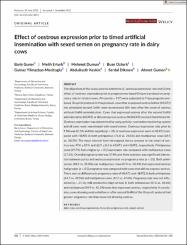| dc.contributor.author | Güner, Barış | |
| dc.contributor.author | Ertürk, Melih | |
| dc.contributor.author | Dursun, Mehmet | |
| dc.contributor.author | Öztürk, Buse | |
| dc.contributor.author | Mecitoğlu, Gülnaz Yılmazbaş | |
| dc.contributor.author | Keskin, Abdulkadir | |
| dc.contributor.author | Dikmen, Serdal | |
| dc.contributor.author | Gümen, Ahmet | |
| dc.date.accessioned | 2023-07-18T07:48:08Z | |
| dc.date.available | 2023-07-18T07:48:08Z | |
| dc.date.issued | 2022 | en_US |
| dc.identifier.issn | 0936-6768 / 1439-0531 | |
| dc.identifier.uri | https://doi.org/10.1111/rda.14293 | |
| dc.identifier.uri | https://hdl.handle.net/20.500.12462/13221 | |
| dc.description | Güner, Barış (Balikesir Author) | en_US |
| dc.description.abstract | The objectives of the study were to determine (1) oestrous expression rate and (2) the
effect of oestrous expression prior to progesterone-based Ovsynch protocol on pregnancy rate in Holstein cows. All cows (n = 917) were subjected to 7-day progesteronebased Ovsynch protocol. In this protocol, cows that expressed oestrus before (HEAT1)
the scheduled second GnRH were inseminated 20 h later after the onset of oestrus
without GnRH administration. Cows that expressed oestrus after the second GnRH
administration (HEAT2) or did not express oestrus (NOHEAT) received fixed-timed AI.
Oestrous expression was determined by using activity-rumination monitoring system
and all cows were inseminated with sexed semen. Oestrous expression rate prior to
FTAI was 40.5% and the majority (p < .01) of oestrous expression were in HEAT2 compared with HEAT1 in both primiparous (71.8 vs. 28.1%) and multiparous cows (69.5
vs. 30.5%). The mean interval from intravaginal device removal to the onset of oestrus was 47.4 ± 0.9 h and 62.9 ± 0.5 in HEAT1 and HEAT2, respectively. Primiparous
cows (47.7%) had a higher (p < .01) expression rate compared with multiparous cows
(37.2%). Overall pregnancy rate was 37.4% and there was two-way significant interaction between parity and oestrous expression on pregnancy rate (p < .01). Both primiparous (48.1 vs. 35.8%) and multiparous cows (47.4 vs. 28.4%) that expressed oestrus
had greater (p < .01) pregnancy rate compared with cows that did not express oestrus.
There was no difference in pregnancy rates of HEAT1 and HEAT2 in both primiparous
(44.7 vs. 49.5%) and multiparous cows (47.2 vs. 47.6%). Pregnancy rate was not influenced (p = .21) by milk production (high or low) in both primiparous (47.6 vs. 48.6%)
and multiparous (54.9 vs. 42.1%) cows that expressed oestrus, respectively. In conclusion, cows showing oestrus before or after second GnRH of the Ovsynch protocol had
greater pregnancy rate than cows not showing oestrus. | en_US |
| dc.language.iso | eng | en_US |
| dc.publisher | Wiley | en_US |
| dc.relation.isversionof | 10.1111/rda.14293 | en_US |
| dc.rights | info:eu-repo/semantics/embargoedAccess | en_US |
| dc.subject | Dairy Cow | en_US |
| dc.subject | Oestrous Expression | en_US |
| dc.subject | Ovsynch | en_US |
| dc.subject | Pregnancy Rate | en_US |
| dc.subject | Sexed Semen | en_US |
| dc.title | Effect of oestrous expression prior to timed artificial insemination with sexed semen on pregnancy rate in dairy cows | en_US |
| dc.type | article | en_US |
| dc.relation.journal | Reproduction in Domestic Animals | en_US |
| dc.contributor.department | Veteriner Fakültesi | en_US |
| dc.contributor.authorID | 0000-0001-6414-6752 | en_US |
| dc.contributor.authorID | 0000-0002-3607-4365 | en_US |
| dc.contributor.authorID | 0000-0003-2405-3572 | en_US |
| dc.identifier.volume | 58 | en_US |
| dc.identifier.issue | 2 | en_US |
| dc.identifier.startpage | 342 | en_US |
| dc.identifier.endpage | 348 | en_US |
| dc.relation.publicationcategory | Makale - Uluslararası Hakemli Dergi - Kurum Öğretim Elemanı | en_US |


















